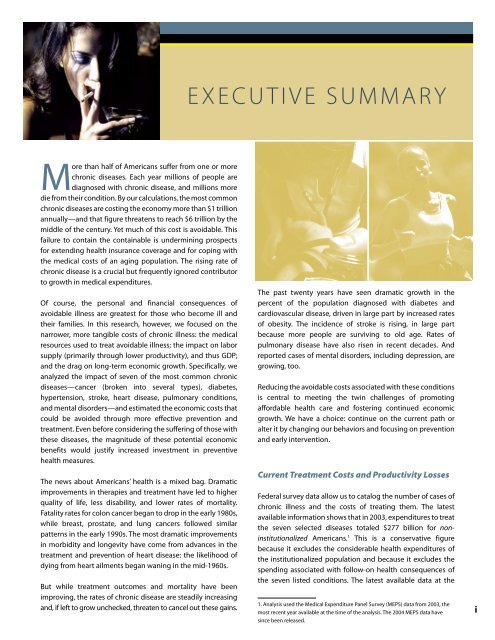An Unhealthy America: The Economic Burden of ... - Milken Institute
An Unhealthy America: The Economic Burden of ... - Milken Institute
An Unhealthy America: The Economic Burden of ... - Milken Institute
Create successful ePaper yourself
Turn your PDF publications into a flip-book with our unique Google optimized e-Paper software.
Executive SummaryMore than half <strong>of</strong> <strong>America</strong>ns suffer from one or morechronic diseases. Each year millions <strong>of</strong> people arediagnosed with chronic disease, and millions moredie from their condition. By our calculations, the most commonchronic diseases are costing the economy more than $1 trillionannually —and that figure threatens to reach $6 trillion by themiddle <strong>of</strong> the century. Yet much <strong>of</strong> this cost is avoidable. Thisfailure to contain the containable is undermining prospectsfor extending health insurance coverage and for coping withthe medical costs <strong>of</strong> an aging population. <strong>The</strong> rising rate <strong>of</strong>chronic disease is a crucial but frequently ignored contributorto growth in medical expenditures.Of course, the personal and financial consequences <strong>of</strong>avoidable illness are greatest for those who become ill andtheir families. In this research, however, we focused on thenarrower, more tangible costs <strong>of</strong> chronic illness: the medicalresources used to treat avoidable illness; the impact on laborsupply (primarily through lower productivity), and thus GDP;and the drag on long-term economic growth. Specifically, weanalyzed the impact <strong>of</strong> seven <strong>of</strong> the most common chronicdiseases—cancer (broken into several types), diabetes,hypertension, stroke, heart disease, pulmonary conditions,and mental disorders—and estimated the economic costs thatcould be avoided through more effective prevention andtreatment. Even before considering the suffering <strong>of</strong> those withthese diseases, the magnitude <strong>of</strong> these potential economicbenefits would justify increased investment in preventivehealth measures.<strong>The</strong> news about <strong>America</strong>ns’ health is a mixed bag. Dramaticimprovements in therapies and treatment have led to higherquality <strong>of</strong> life, less disability, and lower rates <strong>of</strong> mortality.Fatality rates for colon cancer began to drop in the early 1980s,while breast, prostate, and lung cancers followed similarpatterns in the early 1990s. <strong>The</strong> most dramatic improvementsin morbidity and longevity have come from advances in thetreatment and prevention <strong>of</strong> heart disease: the likelihood <strong>of</strong>dying from heart ailments began waning in the mid-1960s.But while treatment outcomes and mortality have beenimproving, the rates <strong>of</strong> chronic disease are steadily increasingand, if left to grow unchecked, threaten to cancel out these gains.<strong>The</strong> past twenty years have seen dramatic growth in thepercent <strong>of</strong> the population diagnosed with diabetes andcardiovascular disease, driven in large part by increased rates<strong>of</strong> obesity. <strong>The</strong> incidence <strong>of</strong> stroke is rising, in large partbecause more people are surviving to old age. Rates <strong>of</strong>pulmonary disease have also risen in recent decades. <strong>An</strong>dreported cases <strong>of</strong> mental disorders, including depression, aregrowing, too.Reducing the avoidable costs associated with these conditionsis central to meeting the twin challenges <strong>of</strong> promotingaffordable health care and fostering continued economicgrowth. We have a choice: continue on the current path oralter it by changing our behaviors and focusing on preventionand early intervention.Current Treatment Costs and Productivity LossesFederal survey data allow us to catalog the number <strong>of</strong> cases <strong>of</strong>chronic illness and the costs <strong>of</strong> treating them. <strong>The</strong> latestavailable information shows that in 2003, expenditures to treatthe seven selected diseases totaled $277 billion for noninstitutionalized<strong>America</strong>ns. 1 This is a conservative figurebecause it excludes the considerable health expenditures <strong>of</strong>the institutionalized population and because it excludes thespending associated with follow-on health consequences <strong>of</strong>the seven listed conditions. <strong>The</strong> latest available data at the1. <strong>An</strong>alysis used the Medical Expenditure Panel Survey (MEPS) data from 2003, themost recent year available at the time <strong>of</strong> the analysis. <strong>The</strong> 2004 MEPS data havesince been released.i
















